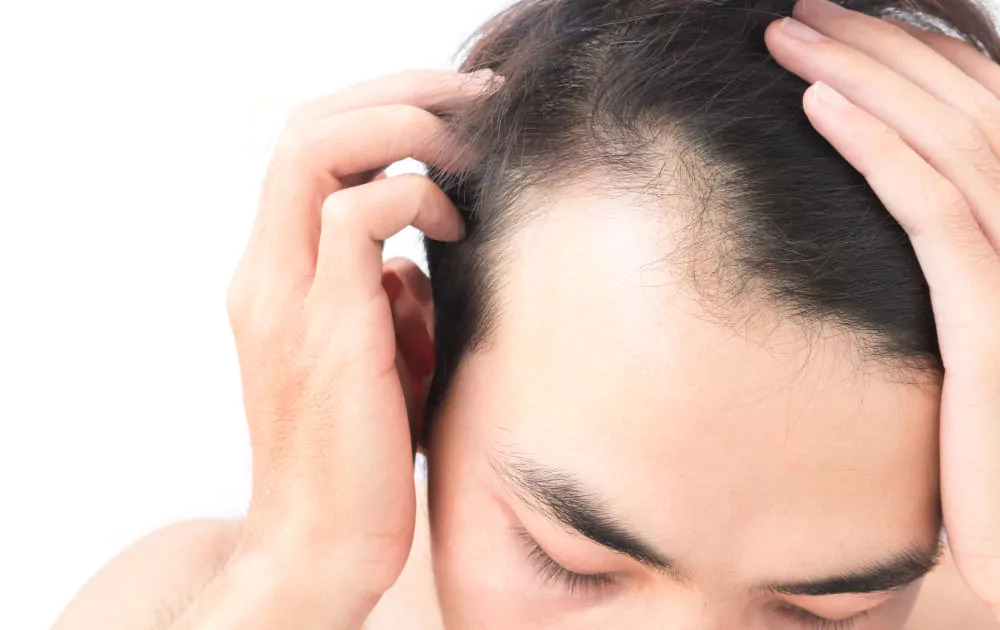Preventive Healthcare
Receding Hairline: Stages, Causes, Treatments And More
14801 Views
0

Hair loss is a common phenomenon that most people face in their lives. It may occur for various reasons such as type of shampoo, water hardness, age, genetics, etc. When hair loss occurs from the front part of the head, it is known as a receding hairline.
Causes of Receding Hairline
Men's Thinning Hairline
After puberty, men can face a receding hairline at any time. By the late '30s, most men face a receding hairline. It generally begins from the temple and moves backward. This hairline looks like a cap on the top of the bare hand. The other types look like a V shape, where hair is thicker in the middle sections. It appears like a widow's peak.
Women's Thinning Hairline
In the case of women, the thinning depends on age, genetics, and hormones. During menopause, a woman's body undergoes many changes, including hair loss.
Why Does Hairline Thinning Occur?
Here are a few factors that contribute to the thinning of a hairline:
- Genetics and family history: A receding hairline is hereditary. If the parents have a receding hairline, their offspring will likely develop it at the same age as their parents.
- Hormones play a major role in hairline thinning.
- Age: With age, hair follicles become weak and damaged. Due to this, when natural hair fall occurs, replacing it with new hair becomes difficult.
- Medical history: Many drugs, diseases, and treatment plans can cause a receding hairline. For example, chemotherapy is well known for causing hair loss and a receding hairline.
- Anxiety: Abrupt hair loss can be brought on by disease or anxiety. People typically describe this as an unanticipated shedding where individuals lose a significant amount of hair in a short amount of time. Fortunately, this hair loss frequently stops on its own.
- Way of life: There can be a connection between certain lifestyle decisions and hair loss. Smokers could lose their hair more quickly than non-smokers.
- Nutrition and thinning hair might also be related. For instance, people who do not consume sufficient protein in regular diets may experience more hair loss than others.
Receding Hairline Hairstyles
You should choose a shorter hairstyle on the sides than on the top, assuming you decide against a clean shave. This is because the hair on the top would appear longer and denser.
Evaluate your facial structure before embracing the clean shave. Some face types suit total balding better than others.
Keep your scalp moisturized, hygienic, and healthy because having a head full of flakes is the last thing you want if your hair is short and thin.
Here are some hairstyle options if you have a receding hairline:
- Buzz cut: This common haircut looks good with retreating hairlines and is simple to keep up.
- Textured layering: You can add rough textures, bright layering, and colour to bring out your hairstyle.
- Faux hawk: Find a balance between modern standards and unrelenting individual expression. It is effective at concealing a thinning forehead because it directs all of your hair toward the center of the crown.
- Au naturale: Consistently groom and trim your hair. It may be your greatest choice, especially if you're an older adult.
- Angled fringe- You can fill in the forehead and cut your ends into an angled fringe. This haircut looks best when worn with fine hair and an untidy appearance.
Hair Transplant for Receding Hairline
In a hair transplant process called Follicular Unit Extraction, donor hair is removed from denser areas and relocated to areas with complete or partial hair loss. In contrast to other procedures, this removes each hair follicle individually, producing little to no evidence of the procedure.
Most types of hair loss can be treated with FUE hair transplants, and noticeable improvements are often visible in three to four months. Other advantages are faster healing time and almost invisible scars.
A hair transplant is typically safe when performed by a qualified, skilled, board-certified cosmetic surgeon. Although soreness, oedema, and irritation may persist for several minutes, days, or weeks following the procedure, much like with various surgical procedures.
Hairline Regrowth
A receding hairline cannot be completely reversed, but several drugs could slow it down and promote hair growth. Some of the drugs are listed below:
- Dutasteride/Finasteride: DHT, produced when testosterone is metabolised in males, can result in baldness on a man's head. Finasteride, sold under Propecia, is a prescription medication for male pattern baldness. It reduces the rate at which testosterone transforms to DHT, lowering DHT levels in the body. Some men might find it simpler to develop hair or see less hair loss. Although it was created to cure an enlarged prostate, the medicine Dutasteride is frequently used to help promote hair repair and development. When a person quits using the drug, these effects usually subside.
- Minoxidil: FDA has authorised over-the-counter medication to help reduce the rate of baldness. The effects typically remain for the duration of the course of therapy, but when an individual stops using it, balding will return.
- Anthralin: Sometimes, people's anthralin prescriptions may promote new hair growth. So despite its role as a topical psoriasis treatment, it is frequently used to encourage hair growth.
- Corticosteroids: A few corticosteroid therapies may also aid in preventing hair loss. By lowering the swelling surrounding the follicles, this medicine causes them to reopen and produce new hairs. However, anyone contemplating using corticosteroids must speak with a specialist first because they could have harmful side effects.
Light Therapy and Hair Transplantation
A hair transplant entails transplanting strands and chunks of skin from thicker regions of the head to the front. Although the procedure is expensive, many people believe it to be a better long-lasting fix for a receding hairline.
Some patients may improve hair growth and decrease male pattern baldness while receiving laser therapy utilising red light, also known as a laser with a 660 nm wavelength.























 WhatsApp
WhatsApp